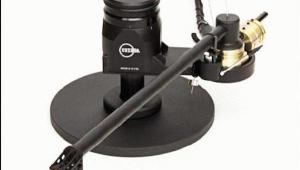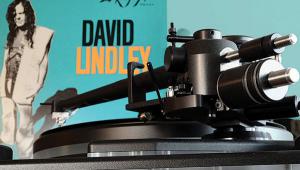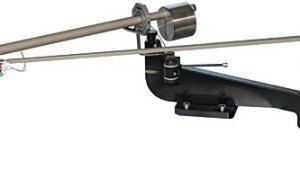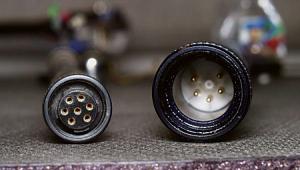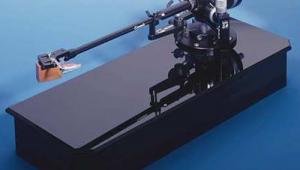Graham Model 2.0 tonearm Michael Fremer July 2002
As reported in April in this column, upgrading to Graham Engineering's new 2.2 bearing cap brings a major improvement to the overall sound of their 2.0 tonearm, but especially in the low frequencies. Bob Graham wanted me to compare an all-new 2.2 with an upgraded 2.0, and once he'd caught up with production, he sent me one. There's been a change to the base plate, from two- to one-piece construction. The internal armwand wiring has also been changed.
Comparing the 2.2 and the upgraded 2.0 was easy: I put the Helikon SL cartridge on the new armwand and listened to assorted reference tracks, then installed the 2.2 on the Simon Yorke 'table and listened again. Aside from the hardware, the only variable was Graham's new blue silicone damping oil. I used Hovland's Music Groove phono cable (Graham also has a new IC-70 cable for the 2.2, which I didn't audition). The phono section was the $29,000 Boulder 2008 (see review elsewhere in this issue).
Some might be skeptical that the change in baseplate yields significant audible differences, thinking that there's no reason for it. However, a spectacularly tiny groove excursion can release an enormous amount of vibrational energy. That's why I think it's critical for a tonearm to be rigidly mounted—the more directly, the better—to its plinth, so that energy can be quickly and effectively evacuated. That's also why the fanatical attention to tight bearing tolerances Rega has paid in their upgraded RB-900 tonearm has paid such obvious sonic dividends—though the arm, for all intents and purposes, looks like any old Rega arm. But more about that in a future review of Rega's upgraded P9 turntable.
The sonic differences between the upgraded 2.0 and the all-new 2.2 arms were easy to hear. The 2.2 had slightly more solidity and weight on bottom, and greater richness and harmonic development in the midrange. The more solid bass was clearly evident on such room-shakers as "Baby You're a Rich Man," from a German pressing of the Beatles' Magical Mystery Tour, and the title track of Davey Spillane's Atlantic Bridge.
Critics of Graham arms point to their "analytical" and underdeveloped midband. That criticism didn't apply to the upgraded 2.0, and even less to the new 2.2. You might not like what either tells you about the record you're playing, but don't blame the messenger.
Should you trade in your old 2.0 for an all-new 2.2, or just upgrade the bearing cap? I'd upgrade; the differences were not major. I think Bob Graham has refined his design about as far as he can, and has kicked the fit'n'finish, already high, up another notch. To surpass what he's accomplished with the 2.2, he'll have to start with a blank piece of paper.
I can't say with absolute authority what is the "best-sounding tonearm in the world," but the Graham 2.2 is among the handful of contenders. Factor in its build quality, ease of setup, versatility, and convenience, and it's hard to beat. And if $3000 is too much for you, you can start with the 2.1 arm ($1995), which is the same basic design fitted with a smaller, lighter bearing cap of aluminum, brass side weights (instead of the 2.2's tungsten), and an aluminum (instead of ceramic) armwand. No setup jig is supplied. You can order a jig at extra cost, or get a WallyTractor (more accurate, but not as convenient, footnote 1). Then, one at a time, you can upgrade the parts until you've got a full-blown 2.2, and you won't have spent any more than if you'd bought an all-new 2.2 to begin with.
Footnote 1: Wally Malewicz, WAM Engineering. Tel./Fax: (763) 478-6685. E-mail: wwmalewi@aol.com. Web, click on "Wally's Vinyl Corner."
- Log in or register to post comments

